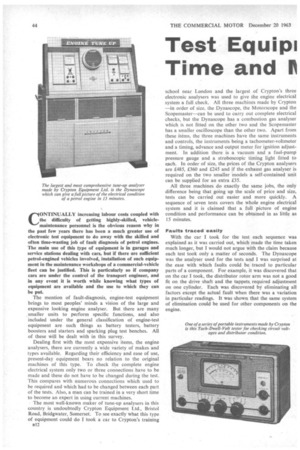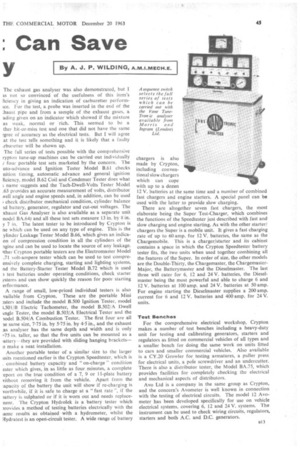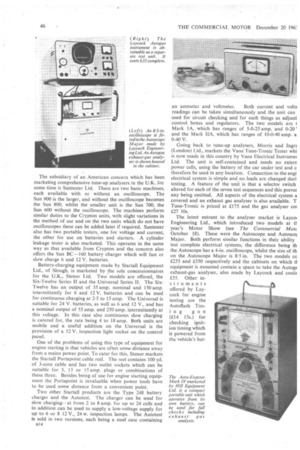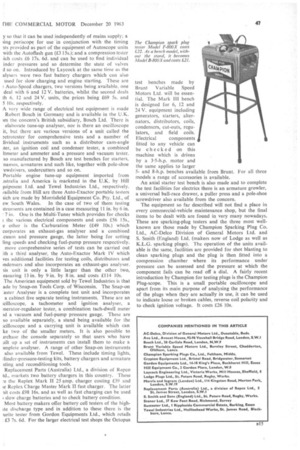Test Equip' Time and P Can Save
Page 46

Page 47

Page 48

Page 49

If you've noticed an error in this article please click here to report it so we can fix it.
CONTINUALLY increasing labour costs coupled with the difficulty of getting highly-skilled, vehiclemaintenance personnel is the obvious reason why in the past few years there has been a much greater use of electronic test equipment to do away with the skilled and often time-wasting job of fault diagnosis of petrol engines. The main use of this type of equipment is in garages and
service stations dealing with cars, but if there are sufficient petrol-engined vehicles involved, installation of such equip ment in the maintenance workshops of a commercial-vehicle fleet can be justified. This is particularly so if company cars are under the control of the transport engineer, and in any event it is worth white knowing what types of equipment are available and the use to which they can be put.
The mention of fault-diagnosis, engine-test equipment brings to most peoples' minds a vision of the large and expensive looking engine analyser. But there are many smaller units to perform specific functions, and also included under the general classification of engine-test equipment are such things as battery testers, battery boosters and starters and sparking plug test benches. All of these will be dealt with in this survey.
Dealing first with the most expensive items, the engine analysers, there are currently a wide variety of makes and types available. Regarding their efficiency and ease of use, present-day equipment bears no relation to the original machines of this type. To check the complete engine electrical system only two or three connections have to be made and these do not have to be changed during the test. This compares with numerous connections which used to be required and which had to be changed between each part of the tests. Also, a man can be trained in a very short time to become an expert in using current machines.
, The most well-known maker of tune-up analysers in this country is undoubtedly Crypton Equipment Ltd., Bristol Road, Bridgwater, Somerset. To see exactly what this type of equipment could do I took a car to Crypton's training a12 school near London and the largest of Crypton's three electronic analysers was used to give the engine electrical system a full check. All three machines made by Crypton —in order of size. the Dynascope, the Ivlotorscope and the Scopemaster—can be used to carry out complete electrical checks, but the Dynascope has a combustion gas analyser which is not fitted on the other two and the Scopernaster has a smaller oscilloscope than the other two. Apart from these items, the three machines have the same instruments and controls, the instruments being a tachometer-voltmeter and a timing, advance and output meter for ignition adjustment. In addition there is a vacuum and a fuel-pump pressure gauge and a stroboscopic timing light fitted to each. In order of size, the prices of the Crypton analysers are £485, £360 and £245 and if the exhaust gas analyser is required on the two smaller models a self-contained unit can be supplied for an extra £35.
All three machines do exactly the same jobs, the only difference being that going up the scale of price and size, tests can be carried out easier and more quickly. A sequence of seven tests covers the whole engine electrical system and it is claimed that a full picture of engine condition and performance can be obtained in as little as 15 minutes.
Faults traced easily With the car I took for the test each sequence was explained as it was carried out, which made the time taken much longer, but I would not argue with the claim because each test took only a matter of seconds. The Dynascope was the analyser used for the tests and I was surprised at the ease with which faults could be traced to particular parts of a component. For example, it was discovered that on the car I took, the distributor rotor arm was not a good fit on the drive shaft and the tappets required adjustment on one cylinder. Each was discovered by eliminating all factors except the actual fault when there was a variation in particular readings. It was shown that the same system of elimination could be used for other components on the engine. The exhaust gas analyser was also demonstrated, but I 3.s not so convinced of the usefulness of this item's 5ciency in giving an indication of carburetter performice. For the test, a probe was inserted in the end of the .haust pipe and from a sample of the exhaust gases, a ading given on an indicator which showed if the mixture as weak, normal or 'rich. This seemed to be a ther hit-or-miss test and one that did not have the same gree of accuracy as the electrical tests. But I will agree at the test tells something and it is likely that a faulty .rburetter will be shown up.
The full series of tests possible with the comprehensive rypton tune-up machines can be carried out individually four portable test sets marketed by the concern. The uto-advance and Ignition Tester Model B.61 checks nition timing, automatic advance and general ignition ficiency, model B.62 Coil and Condenser Tester does what ; name suggests and the Tach-Dwell-Volts Tester Model .63 provides an accurate measurement of volts, distributor well angle and engine speeds and, in addition, can be used o check distributor mechanical condition, cylinder balance id battery, generator, regulator and cut-out voltages. The xhaust Gas Analyser is also available as a separate unit nodel BA.64) and all these test sets measure 13 in. by 8 in. y 7 in. The latest tester to be introduced by Crypton is ne which can be used on any type of engine. This is the ylinder Leakage Tester Model B.66, which gives an indicaon of compression condition in all the cylinders of the agine and can be used to locate the source of any leakage. nher Crypton portable testers are the Electromaster Model .71 volt-ampere tester which can be used to test compreensively complete charging, starting and lighting systems, ad the Battery-Starter Tester Model B.72 which is used test batteries under operating conditions, check starter istems and can show quickly the reason for poor starting erformance.
A range of small, low-priced individual testers is also vailable from Crypton. These are the portable Mini ssters and include the model B.500 Ignition Tester, model 1.501/B Electric Tachometer, the model B.502/A Dwell Lngle Tester, the model B.503/A Electrical Tester and the soda B.504/A Combustion Tester. The first four are all se same size, 7-75 in. by 5-75 in. by 4-5 in., and the exhaust as analyser has the same depth and width and is only 1-75 in. taller, so that the five units can be mounted as a ,attery—they are provided with sliding hanging brackets—
o make a neat installation.
Another portable tester of a similar size to the larger ,nits mentioned earlier is the Crypton Speedtester, which is combined battery capacity and "on-charge" condition ester which gives, in as little as four minutes, a complete eport on the true condition of a 7, 9 or 11-plate battery vithout removing it from the vehicle. Apart from the apacity of the battery the unit will show if re-charging is vorthwhile, if it is safe to charge at a "fast rate ", if the )attery is sulphated or if it is worn out and needs replacenem. The Crypton Hydrolek is a battery tester which n-ovides a method of testing batteries electrically with the ;amc results as obtained with a hydrometer, whilst the Elydratest is an open-circuit tester. A wide range of battery
chargers is also made by Crypton, including conventional slow chargers which can cope with up to a dozen 12 V. batteries at the same time and a number of combined fast chargers and engine starters. A special panel can be used with the latter to provide slow charging.
There are altogether seven fast chargers, the most elaborate being the Super Test-Charger, which combines the functions of the Speedtester just described with fast and slow charging and engine starting. As with the other starter/ chargers the Super is a mobile unit. It gives a fast charging rate of up to 60 amp. for 12 V. batteries, the same as the Chargemobile. This is a charger/starter and its cabinet contains a space in which the Crypton Speedtester battery tester fits, the two units when used together combining all the features of the Super. In order of size, the other models are the Double-Thirty, the Chargemaster, the ChargemasterMajor, the Batterymaster and the Dieselmaster. The last three will cater for 6, 12 and 24 V. batteries, the Dieselmaster being the most powerful and able to charge 6 and 12 V. batteries at 100 amp. and 24 V. batteries at 50 amp. For engine starting the Diesehnaster supplies a 200 amp. current for 6 and 12 V. batteries and 400 amp. for 24 V. units.
Test Benches
For the comprehensive electrical workshop, Crypton makes .a number of test benches including a heavy-duty unit for testing and calibrating generators, starters and regulators as fitted on commercial vehicles of all types and a smaller bench for doing the same work on units fitted to cars and smaller commercial vehicles. Also available is a CY.20 Growler for testing armatures, a puller press for electrical units, a pole screwdriver and an undercutter. There is also a distributor tester, the Model BA.75, which provides facilities for completely checking the electrical and mechanical aspects of distributors.
Avo Ltd is a company in the same group as Crypton, and the concern's Avometer is well known in connection with the testing of electrical circuits. The model 12 Avometer has been developed specifically for use on vehicle electrical systems, covering 6, 12 and 24 V. systems. The instrument can be used to check wiring circuits, regulators, starters and both A.C. and D.C. generators.
The subsidiary of an American concern which has been marketing comprehensive tune-up analysers in the U.K. for some time is Suntester Ltd. There are two basic machines, each available with Or without an oscilloscope. The Sun 900 is the larger, and without the oscilloscope becomes the Sun 800, whilst the smaller unit is the Sun 700, the Sun 600 without the oscilloscope. The machines perform similar duties to the Crypton units, with slight variations in the method of use and on the two units which do not have oscilloscopes these can be added later if required. Suntester also has two portable testers, one for voltage and current, the other for use on batteries and starters. A cylinder leakage tester is also marketed. This operates in the same way as that available from Crypton and the concern also offers the Sun BC-160 battery charger which will fast or slow charge 6 and 12 V. batteries.
Battery-charging equipment made by Startall Equipment Ltd., of Slough, is marketed by the sole concessionnaires for the U.K., Stenor Ltd. Two models are offered, the Six-Twelve Series II and the Universal Series II. The SixTwelve has an output of 35 amp. nominal and 150 amp. intermittently for 6 and 12 V. batteries and can be used for continuous charging at 2-5 to 15 amp. The Universal is suitable for 24 V. batteries, as well as 6 and 12 V., and has a nominal output of 55 amp. and 250 amp. intermittently at this voltage. In this case also continuous slow charging is catered for, the rate being 4 to 18 amp. Both units are mobile and a useful addition on the Universal is the provision of a 12 V. inspection light socket on the control panel.
One of the problems of using this type of equipment for engine starting is that vehicles are often some distance away from a mains power point. To cater for this, Stenor markets the Startall Portapoint cable reel. The reel contains 100 yd. of 3-core cable and has two outlet sockets which can be suitable for 5, 13 or 15 amp. plugs or combinations of these three. Besides being of use for engine starting equipment the Portapoint is invaluable when power tools have to be used some distance from a convenient point.
Two other Startall products are the Type 248 battery charger and the Autotest. The charger can be used for slow charging--at from 2 to 8 amp. for up to 24 cells and in addition can be used to supply a low-voltage supply for up to 6 or 8 12 V., 24w. inspection lamps. The Autotest is sold in two versions, each being a steel case containing B14 an ammeter and voltmeter. Both current and volta readings can be taken simultaneously and the unit can used for circuit checking and for such things as adjusti control boxes and regulators. The two models are t Mark 1A, which has ranges of 5-0-25 amp. and 0-20' and the Mark HA, which has ranges of 10-0-40 amp. a 0-40 V.
Going back to tune-up analysers, Morris and Ingra (London) Ltd., markets the Vane Tune-Tronic Tester whi is now made in this country by Vane Electrical Instrumet Ltd. The unit is self-contained and needs no exterr power cells, using the battery of the car under test and c, therefore be used in any location. Connection to the engi electrical system is simple and no leads are changed duni testing. A feature of the unit is that a selector switch altered for each of the seven test sequences and this prever any being omitted. All aspects of the electrical system a covered and an exhaust gas analyser is also available. T Tune-Tronic is priced at £175 and the gas analyser co! £27 10s.
The latest entrant to the analyser market is Laycol Engineering Ltd., which introduced two models at tt year's Motor Show (see The Commercial Mote October 18). These were the Autoscope and Autoscoi Major. Both perform similar functions in their ability test complete electrical systems, the difference being th the Autoscope has a 4-in, oscilloscope, whilst the size of th on the Autoscope Major is 8.5 in. The two models co £255 and £350 respectively and the cabinets on which tl equipment is mounted contain a space to take the Autoga exhaust-gas analyser, also made by Laycock and costit £35. Other inst r um en ts offered by Laycock for engine testing are the Autoflash Tim
ing gun (£14 15s.) for checking ignition timing which is powered from the vehicle's bat
y so that it can be used independently of mains supply; a ling periscope for use in conjunction with the timing
tits provided as part of the equipment of Autoscope units with the Autoflash gun (£3 15s.); and a compression tester ich costs £6 17s. 6d. and can be used to find individual inder pressures and so determine the state of valves I so on. Introduced by Laycock at the same time as the alysers were two fast battery chargers which can also used for slow charging and engine starting. These are Auto-Speed chargers, two versions being available, one deal with 6 and 12 V. batteries, whilst the second deals th 6, 12 and 24 V. units, the prices being £69 5s. and 5 10s. respectively.
A very wide range of electrical test equipment is made Robert Bosch in Germany and is available in the U.K. an the concern's British subsidiary, Bosch Ltd. There is elaborate tune-up analyser, nor is there an oscilloscope it, but there are various versions of a unit called the 2..ctrotester for comprehensive tests and a number of lividual instruments such as a distributor cam-angle ter, an ignition coil and condenser tester, a combined ltmeter and ammeter and a pressure and vacuum tester. so manufactured by Bosch are test benches for starters, namos, armatures and such like, together with pole-shoe vwdrivers, undercutters and so on.
Portable engine tune-up equipment imported from istralia and America is marketed in the U.K. by Hill luipment Ltd. and Tewel Industries Ltd., respectively. iailable from Hill are three Auto-Exactor portable testers Lich are made by Morrisfield Equipment Co. Pty. Ltd., of ew South Wales. In the case of two of them testing struments are contained in a case measuring 11 in. by 6 in.
• 7 in. One is the Multi-Tuner which provides for checks the various electrical components and costs £56 I 5s„ e other is the Carburation Meter (£49 10s.) which corporates an exhaust-gas analyser and a combined cuum and pressure gauge, the latter being for setting ling speeds and checking fuel-pump pressure respectively. more comprehensive series of tests can be carried out th a third analyser, the Auto-Exactor Mark IV which ves additional facilities for testing coils, distributors and indensers and also incorporates an exhaust-gas analyser. Us unit is only a little larger than the other two, easuring 13 in. by 9 in. by 8 in. and costs £114 10s. The American equipment sold by Tewel Industries is that ade by Snap-on Tools Corp. of Wisconsin. The Snap-on aster Analyser is a complete test unit and incorporates a cabinet five separate testing instruments. These are an cilloseope, a tachometer and ignition analyser, a inerator-regulator tester, a combination tach-dwell meter id a vacuum and fuel-pump pressure gauge. These are so available separately, a stand being available for the icilloscope and a carrying unit is available which can ke two of the smaller meters. It is also possible to irchase the console separately so that users who have jilt up a set of instruments can install them to make a nnplete analyser. A range of other Snap-on instruments also available from Tewel. These include timing lights, Inder-pressure-testing kits, battery chargers and armature sting and reconditioning tools.
Replacement Parts (Australia) Ltd., a division of Repco td., markets two battery chargers in this country. These e the Replex Mark II 25 amp. charger costing £39 and Replex Charge Master Mark II fast charger. The latter Tit costs £98 16s. and as well as fast charging can be used slow charge batteries and to check battery condition. Most battery makers offer battery cell testers of the highite discharge type and in addition to these there is the urite tester from Gordon Equipments Ltd., which retails £3 7s. 6d. For the larger electrical test shops the Octopus test benches made by 13runt Variable Speed Motors Ltd. will be essential. The Mark HI bench is designed for 6, 12 and 24 V. equipment including generators, starters, alternators, distributors, coils, condensers, cut-outs, regulators, and field coils.
Electrical components fitted to any vehicle can be check ed •on this machine which is driven by a 3-5-h.p. motor and the same applies to larger 5and 8-h.p. benches available from Brunt. For all three models a range of accessories is available.
An axial starter test bench is also made and to complete the test facilities for electrics there is an armature growler, a universal ball-race drawer, a puller press and a pole-shoe screwdriver also available from the concern.
The equipment so far described will not find a place in every commercial-vehicle maintenance shop, but the final items to be dealt with are found in very many nowadays. These are sparking-plug testers and the three most wellknown are those made by Champion Sparking Plug Co. Ltd., AC-Delco Division of General Motors Ltd. and S. Smith (England) Ltd. (makers now of Lodge as well as K.L.G. sparking plugs). The operation of the units available is the same, facilities are provided for shot blasting to clean sparking plugs and the plug is then fitted into a compression chamber where its performance under pressure can be assessed and the pressure at which the component faits can be read off a dial. A fairly recent introduction by Champion for testing plugs is the Champion Plug-scope. This is a small portable oscilloscope and apart from its main purpose of analysing the performance of the plugs when they are actually in use, it can be used to indicate loose or broken cables, reverse coil polarity and to check ignition voltage. It costs £26 10s.




























































































